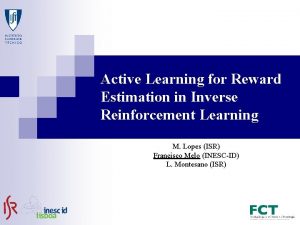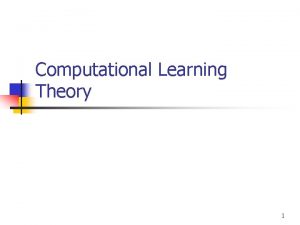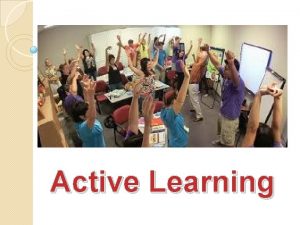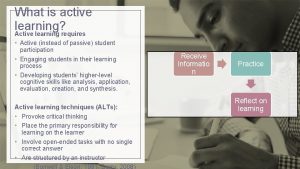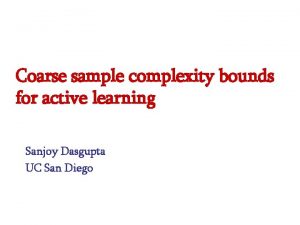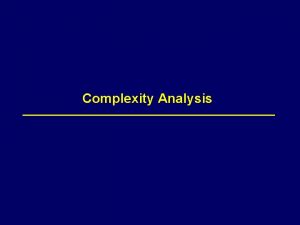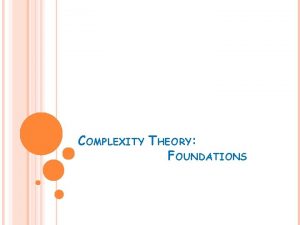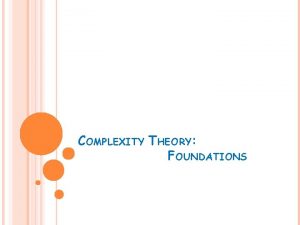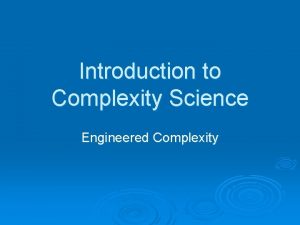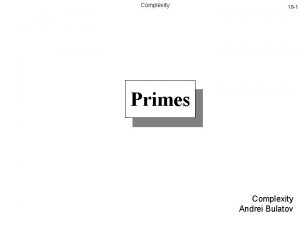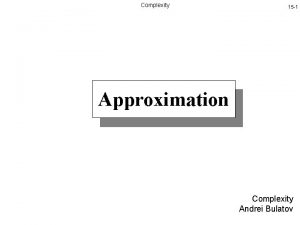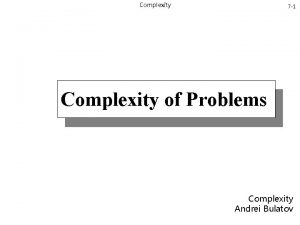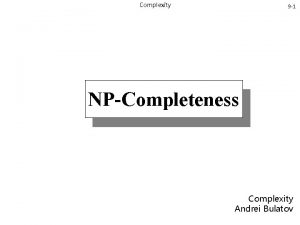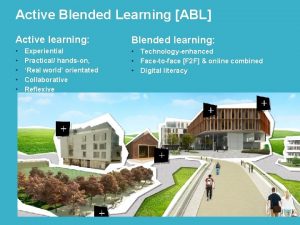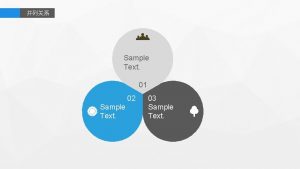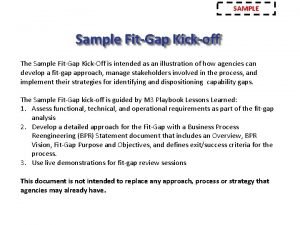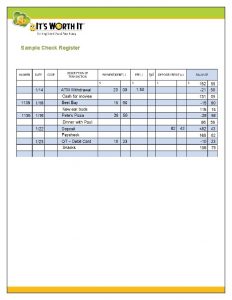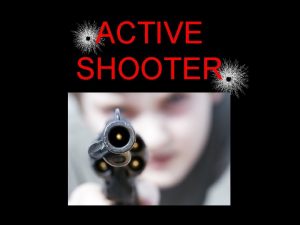The True Sample Complexity of Active Learning Steve









![A More Subtle Example: Intervals Suppose D is uniform on [0, 1] 0 - A More Subtle Example: Intervals Suppose D is uniform on [0, 1] 0 -](https://slidetodoc.com/presentation_image_h2/3ab3bfe38d67da5c0e450f71f19bcdf6/image-10.jpg)
![A More Subtle Example: Intervals Suppose D is uniform on [0, 1] } } A More Subtle Example: Intervals Suppose D is uniform on [0, 1] } }](https://slidetodoc.com/presentation_image_h2/3ab3bfe38d67da5c0e450f71f19bcdf6/image-11.jpg)


![Active Learning Always Helps! [HLW 94] passive algorithm has O(1/ ) sample complexity. Steve Active Learning Always Helps! [HLW 94] passive algorithm has O(1/ ) sample complexity. Steve](https://slidetodoc.com/presentation_image_h2/3ab3bfe38d67da5c0e450f71f19bcdf6/image-14.jpg)

















- Slides: 31

The True Sample Complexity of Active Learning Steve Hanneke Machine Learning Department Carnegie Mellon University shanneke@cs. cmu. edu Joint work with Maria-Florina Balcan Computer Science Department Carnegie Mellon University ninamf@cs. cmu. edu and Jennifer Wortman Computer and Information Science University of Pennsylvania wortmanj@seas. upenn. edu

Passive Learning Data Source Expert / Oracle Learning Algorithm Raw Unlabeled Data Labeled examples Algorithm outputs a classifier Steve Hanneke 2

Active Learning Algorithm Data Source Expert / Oracle Raw Unlabeled Data Request for the label of an example The label of that example Request for the label of another example The label of that example. . . Algorithm outputs a classifier Steve Hanneke 3

Active Learning Algorithm Data Source Expert / Oracle How many label requests are required to learn? Sample Complexity Raw Unlabeled Data Request for the label of an example The label of that example Request for the label of another example The label of that example. . . e. g. , Das 04, Das 05, DKM 05, BBL 06, Kaa 06, Han 07 a&b, BBZ 07, DHM 07 Algorithm outputs a classifier Steve Hanneke 4

Active Learning Sometimes Helps An Example: 1 -dimensional threshold functions. - + Steve Hanneke 5

Active Learning Sometimes Helps An Example: 1 -dimensional threshold functions. Take m unlabeled examples Repeatedly request the label of the median point between -/+ boundaries. Take any threshold consistent with the observed labels. - - - - -- -+ + + + Used only log(m) label requests, but get a classifier consistent with all m examples! Exponential improvement over passive! Steve Hanneke 6

Outline Formal Model An Illustrative Example Exciting New Results Conclusions & Open Problems Steve Hanneke 7

Formal Model Steve Hanneke 8

Sample Complexity budget target-dependent Steve Hanneke 9
![A More Subtle Example Intervals Suppose D is uniform on 0 1 0 A More Subtle Example: Intervals Suppose D is uniform on [0, 1] 0 -](https://slidetodoc.com/presentation_image_h2/3ab3bfe38d67da5c0e450f71f19bcdf6/image-10.jpg)
A More Subtle Example: Intervals Suppose D is uniform on [0, 1] 0 - + - 1 Steve Hanneke 10
![A More Subtle Example Intervals Suppose D is uniform on 0 1 A More Subtle Example: Intervals Suppose D is uniform on [0, 1] } }](https://slidetodoc.com/presentation_image_h2/3ab3bfe38d67da5c0e450f71f19bcdf6/image-11.jpg)
A More Subtle Example: Intervals Suppose D is uniform on [0, 1] } } } } } } } } 2 2 2 2 2 2 2 2 0 1 Suppose the target labels everything “-1” How many labels are needed to verify that a given h has er(h) < ? Need (1/ ) label requests to guarantee the target isn’t one of these (1/ ) sample complexity? Steve Hanneke 11

A More Subtle Example: Intervals Algorithm: Take a large number of unlabeled examples. Phase 1: Query random examples until we find a +1 example. (if use all n label requests before finding a +1 example, return the empty interval) Phase 2: Do binary searches to the left and right of the +1 point. After n total label requests, return any consistent h C. - - - + + +- - - Steve Hanneke 12

Can Active Learning Always Help? Steve Hanneke 13
![Active Learning Always Helps HLW 94 passive algorithm has O1 sample complexity Steve Active Learning Always Helps! [HLW 94] passive algorithm has O(1/ ) sample complexity. Steve](https://slidetodoc.com/presentation_image_h2/3ab3bfe38d67da5c0e450f71f19bcdf6/image-14.jpg)
Active Learning Always Helps! [HLW 94] passive algorithm has O(1/ ) sample complexity. Steve Hanneke 14

Proof Outline Claim 1: The result is certainly true for “threshold-esc” problems – where the problem gets easier the longer we work at it (based on [Hanneke 07], “disagreement coefficient” analysis) Claim 2: Any C can be partitioned into C 1, C 2, C 3, … with this property. Claim 3: There is an aggregation algorithm that uses all of C 1, C 2, C 3, … but is never much worse than using just the Ci that contains the target f.

How Much Better? In a sense, the o(1/ ) results is the strongest possible result at this level of generality. But can we prove stronger results for specific pairs (C, D)? Steve Hanneke 16

Exponential Improvements It is often possible to achieve polylogarithmic sample complexity for all targets. For example: linear separators, under uniform distributions on an r-sphere Axis-aligned rectangles, under uniform distributions on [0, 1]r Decision trees with axis-aligned splits, under uniform distributions on [0, 1] r Finite unions of intervals on the real line (arbitrary distributions) Can also preserve polylog sample complexities under some transformations: Unions, “close” distributions, mixtures of distributions Steve Hanneke 17

Conclusions Active learning can always achieve a strictly superior asymptotic sample complexity compared to passive learning. For most natural learning problems, the improvements are exponential. Often the amount of improvement is not detectable from observable quantities (e. g. , for intervals). Steve Hanneke 18

Open Problems Generalizing to agnostic learning General conditions for learnability at an exponential rate Reversing the order of quantifiers regarding D in the model Steve Hanneke 19

Thank You Special thanks to Yishay Mansour for suggesting this perspective, and to Eyal Even-Dar, Michael Kearns, Larry Wasserman & Eric Xing for discussions and feedback. Steve Hanneke 20

Models of Learning Number of labels before we can find a good classifier vs number of labels before we can both find a good classifier and know we have found one. Steve Hanneke 21

How Much Better? In a sense, the o(1/ ) results is the strongest possible result at this level of generality. 1 ( 2) 2 3 ( 3) … 0 But can we prove stronger results for specific pairs (C, D)? Steve Hanneke 22

Exponential Improvements We can extend these results by altering the hypothesis class or distribution in ways that preserve learnability at an exponential rate. Steve Hanneke 23

Proof Sketch Steve Hanneke 24

Proof Sketch Steve Hanneke 25

Proof Sketch Steve Hanneke 26

Proof Sketch Steve Hanneke 27

Proof Sketch … … … … Maximum recursion depth ≤ d Steve Hanneke 28

Proof Sketch Steve Hanneke 29

Proof Sketch Steve Hanneke 30

Proof Sketch Steve Hanneke 31
 Time space complexity of algorithm
Time space complexity of algorithm Steve jobs steve wozniak ronald wayne
Steve jobs steve wozniak ronald wayne Active and passive learners
Active and passive learners Inverse reinforcement learning
Inverse reinforcement learning Sample complexity for finite hypothesis spaces
Sample complexity for finite hypothesis spaces True love steve maclean
True love steve maclean Cuadro comparativo entre e-learning b-learning y m-learning
Cuadro comparativo entre e-learning b-learning y m-learning 102 dr
102 dr Chapter 2 jesus christ true god and true man
Chapter 2 jesus christ true god and true man Boolean operators
Boolean operators Primary active transport and secondary active transport
Primary active transport and secondary active transport Primary active transport vs secondary active transport
Primary active transport vs secondary active transport Hình ảnh bộ gõ cơ thể búng tay
Hình ảnh bộ gõ cơ thể búng tay Bổ thể
Bổ thể Tỉ lệ cơ thể trẻ em
Tỉ lệ cơ thể trẻ em Chó sói
Chó sói Chụp phim tư thế worms-breton
Chụp phim tư thế worms-breton Chúa sống lại
Chúa sống lại Các môn thể thao bắt đầu bằng tiếng bóng
Các môn thể thao bắt đầu bằng tiếng bóng Thế nào là hệ số cao nhất
Thế nào là hệ số cao nhất Các châu lục và đại dương trên thế giới
Các châu lục và đại dương trên thế giới Công thức tính thế năng
Công thức tính thế năng Trời xanh đây là của chúng ta thể thơ
Trời xanh đây là của chúng ta thể thơ Cách giải mật thư tọa độ
Cách giải mật thư tọa độ 101012 bằng
101012 bằng Phản ứng thế ankan
Phản ứng thế ankan Các châu lục và đại dương trên thế giới
Các châu lục và đại dương trên thế giới Thể thơ truyền thống
Thể thơ truyền thống Quá trình desamine hóa có thể tạo ra
Quá trình desamine hóa có thể tạo ra Một số thể thơ truyền thống
Một số thể thơ truyền thống Cái miệng xinh xinh thế chỉ nói điều hay thôi
Cái miệng xinh xinh thế chỉ nói điều hay thôi



